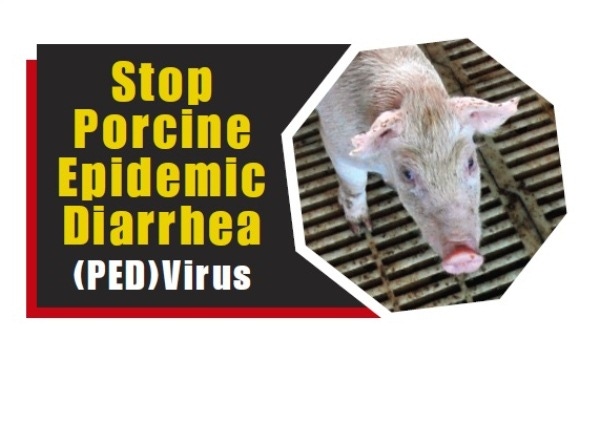March 24, 2014

More than 60 people representing U.S. and Canadian pork, feed and other allied industries recently participated in a meeting focusing on the porcine epidemic diarrhea virus (PEDV) issue, hosted by the National Pork Board, and in collaboration with the National Pork Producers Council, the American Association of Swine Veterinarians, the American Feed Industry Association, the National Grain and Feed Association, the National Renderers Association and the North American Spray Dried Blood and Plasma Producers, in Des Moines, IA.
Although the disease does not affect humans or pork safety, it has infected and killed millions of young pigs on farms of all sizes in 27 states since May 2013 and in four Canadian provinces since January.
"Our main goal was to bring a group of people together to help us agree on research needs related to PEDV and feed systems so that we can get answers to ongoing questions as quickly and efficiently as possible," said Paul Sundberg, DVM, vice president of science and technology at the National Pork Board. "We've been working on PEDV research and collaborating with all pork industry stakeholders since the disease was discovered here, and we'll continue doing that to get practical results for farmers to use to save their pigs."
The meeting participants, made up of producers, veterinarians, nutritionists, academics and government and association officials, also shared what's currently known about PEDV, including transmission routes, possible vectors and current testing limitations. The group reiterated that PEDV is not a human health or food safety issue and agreed the virus is of Asian origin genetically, but its direct pathway to North America remains unknown.
Like what you’re reading? Subscribe to the National Hog Farmer Weekly Preview newsletter and get the latest news delivered right to your inbox every week!
"The feed and ingredient associations appreciate the National Pork Board and pork industry for organizing this important roundtable discussion," said Richard Sellers, senior vice president of legislative and regulatory affairs with the American Feed Industry Association (AFIA). "The research agenda outcome from the meeting is one we are optimistic will assist in investigating this devastating disease more in depth, helping to develop mitigation steps and communicating to those in our respective industries."
During the day-long session, the U.S. Department of Agriculture offered information about the agency's pathways analysis that seeks to identify and describe pathways that exotic viral pathogens of swine may enter the country. The Canadian participants shared their PEDV experiences and actions taken this year, and the American Association of Swine Veterinarians presented its initial survey of early PEDV cases. In addition, participants learned results of veterinary investigations in several states and heard what the feed, feed ingredient and rendering industries are doing to enhance their biosecurity programs and mitigate risk.
"After taking all of this information into consideration, the group agreed that there are multiple ways for pigs to become infected via a fecal-oral route, including environmental, transportation, feed systems and other vectors," Sundberg said.
The top research priorities agreed upon by the group are: 1) to investigate the effectiveness and cost of treatments that could be used to mitigate the survival of PEDV and other viruses in feeds, 2) to conduct contamination risk assessments at all steps within the feed processing and delivery chain, 3) to develop a substitute for the currently used swine bioassay procedures and 4) to continue to investigate the risk of feed and other pathways for pathogen entry into the U.S.
"If feed is a factor in the transfer of PEDV, based on past research we know that there are specific time and temperature combinations that should inactivate the virus," Sundberg said. "However, there are many variables that can affect feed, including post-processing contamination, which is another area that must be carefully controlled even if inactivation occurs."
David Fairfield, vice president of feed services for the National Grain and Feed Association (NGFA), said, "This meeting illustrates the ongoing commitment that all participants in the pork industry have in eliminating PEDV. The dialogue was constructive and transparent, and facilitated a better understanding on what is known and not known about the disease. NGFA believes the feed-related research priorities identified during the meeting are appropriate and will provide important information that can be used as part of a comprehensive strategy to eradicate PEDV."
To date, the Pork Checkoff has funded 17 PEDV-related research projects totaling nearly $1.7 million. The Institute for Feed Research and Education, AFIA's foundation, has pledged $100,000 toward PEDV research.
AFIA's Sellers added, "To show our dedication, industry groups are committing resources and funding to the research effort and will continue to communicate updates to those affected in order to minimalize further effects."
You might also like:
High Hog Prices Come with Complicated Consequences and a Positive Export Picture
Large Reductions Estimated in Hog Supply Due to PEDV
Exposing Sows to PEDV to Build Herd Immunity
You May Also Like



